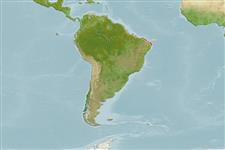>
Blenniiformes (Blennies) >
Dactyloscopidae (Sand stargazers)
Etymology: Platygillellus: Greek, platys = flat + Theodore Nicolas Gill (1837-1914) researcher of abyssal fishes and systematics (Ref. 45335); brasiliensis: Named for its distribution and probably endemic in Brazil.
Environment: milieu / climate zone / depth range / distribution range
экология
морской демерсальный; пределы глубины 1 - 2 m (Ref. 56973). Tropical
Southwest Atlantic: Brazil.
Size / Вес / Возраст
Maturity: Lm ? range ? - ? cm
Max length : 4.1 cm SL самец/пол неопределен; (Ref. 56973); 4.0 cm SL (female)
Краткое описание
определительные ключи | морфология | морфометрия
Diagnosis: The dorsal finlet is fan-like and 3-spined, its height more than half of predorsal length, 58-84% (vs. 4-spined in P. smithi, low profile in P. rubrocinctus); first 2 spines of finlet more closely spaced than the 2nd and 3rd. Lateral line deflection is usually located below interspace between 14th and 15th dorsal fin elements. Upper lip fimbriae more numerous than those of lower lip. Base of pectoral fin usually naked or rarely with a single scale on its upper portion (Ref. 56973).
Known from shallow reefs; inhabits the margins of sand flats in small caves and below reef walls at depths of 1 to 6 meters; these areas are deposits of coarse gravel largely composed of f fragments of mollusc shells, crustaceans, corals, calcareous algae and sea urchin skeletons and spines. Found buried in the gravel, with just the eyes and the dorsal finlet exposed; it appears to 'swim' in the gravel; solitary or in groups. Associates with other sand-dwelling fishes such as Dactyloscopus tridigitatus, D. crossotus, Gillellus greyae, and toadfish Thallasophynne punctata; also an unidentified shrimp and juveniles of crabs (Callinectes sp.).
Life cycle and mating behavior
половая зрелость | размножение | нерест | икра | Fecundity | личинки
Feitoza, B.M., 2002. Platygillellus brasiliensis n. sp. (Perciformes: Dactyloscopidae), the third species of the genus from the Atlantic. aqua, J. Ichthyol. Aquat. Biol. 6(1):21-28. (Ref. 56973)
Статус Красного Списка МСОП (Ref. 130435: Version 2024-2)
Угроза для людей
Harmless
Использование человеком
дополнительная информация
инструменты
Специальные отчеты
Скачать в формате XML
ресурсы в Интернет
Estimates based on models
Preferred temperature (Ref.
123201): 27 - 27.6, mean 27.5 °C (based on 44 cells).
Phylogenetic diversity index (Ref.
82804): PD
50 = 0.5156 [Uniqueness, from 0.5 = low to 2.0 = high].
Bayesian length-weight: a=0.00389 (0.00180 - 0.00842), b=3.12 (2.94 - 3.30), in cm total length, based on all LWR estimates for this body shape (Ref.
93245).
Trophic level (Ref.
69278): 4.0 ±0.6 se; based on size and trophs of closest relatives
Fishing Vulnerability (Ref.
59153): Low vulnerability (10 of 100).
